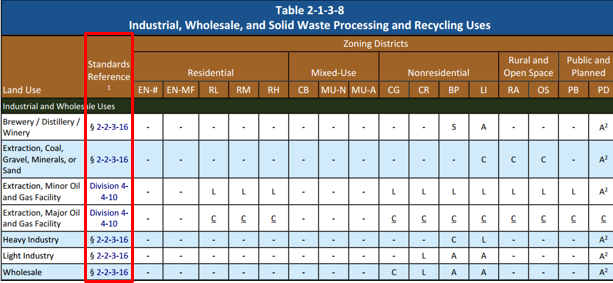Table of Contents

Use-specific standards are used by communities to place limitations on, or apply conditions or specific standards to, certain land uses. Use-specific standards are an effective strategy for neighborhood protection, resource protection, and risk avoidance. Use-specific standards are adopted by ordinance as part of the zoning code, but the complexity and organization of these standards varies widely across communities. As with many other zoning tools, use-specific standards can be calibrated to serve a particular purpose (such as hazard mitigation), can apply to some or all zoning districts or subareas, and can be linked to one or multiple land uses. Communities commonly apply use-specific standards to potentially problematic land uses such as liquor stores, late-night uses, pawn shops, and marijuana facilities. Such uses often come with specific challenges, such as perceptions of increased crime or traffic. Use-specific standards might require limited hours of operation, added security measures, or limiting the number of such uses within a geographic area.
A typical zoning code will describe the types of uses permitted within each zoning district and reference any additional standards that apply to that use. Communities should consider the following when developing new use-specific standards:
- Define the purpose for the use-specific standard. Is the standard necessary to protect people or property from hazards? Is it connected to other community-wide goals or policies?
- Define the areas where the use-specific standard applies. Should the additional standard apply to certain zoning districts or subareas? Should it apply to any parcel that proposes that particular land use?
- Articulate the minimum standard required to mitigate the problem. Determine whether the standard can be reviewed for compliance without a public hearing.
- Is the standard enforceable given current community resources?
Durango applies use-specific standards to dozens of allowable uses. In particular, heavy industry must comply with use-specific standards such as limited parcel areas for proposed development, additional setbacks, limitations on outdoor storage, and requirements for a truck routing plan (for hazardous materials). Durango’s permitted use matrices make it clear to the reader which land uses are required to meet additional use-specific standards (Durango Land Use and Development, 2014).
Developing use-specific standards to address potential hazard risks can be undertaken along with other zoning code amendments, and offer the following benefits:
- Accommodate safety and nuisance protection while allowing reasonable economic use of the property. A particular use might still be viable on a site, as long as it meets additional conditions.
- Can be tailored to a community’s needs. Use-specific standards can apply to a land use in certain geographies, zoning districts, or based on adjacencies. They can also be drafted to require a higher level of scrutiny through the approval process.
- Use-specific standards encourage consistent treatment of similar uses across the board.
- Use-specific standards can accomplish multiple community goals. For example, standards can be drafted for industrial uses that protect surrounding neighborhoods from noise and air pollution, while also preserving open space and natural hazard areas.
As with any zoning code amendment, writing and passing new use-specific standards can be politically and administratively challenging. Developers may object to any new standards without a clear rationale. Other potential challenges include:
- Use-specific standards can result in the inability to develop a particular use on a landowner’s parcel if it cannot meet defined standards for public safety and welfare.
- Use-specific standards can be perceived as inequitably targeting certain uses in a community.
- Developing use-specific standards requires substantial analysis (e.g., reviewing technical standards as they apply to industry standards and/or researching national best practices) to effectively accomplish the purpose without over-regulating.

 Similarly, San Miguel County adopted use-specific standards as part of its zoning code amendments prepared for the Wright’s Mesa area in 2010. The standards reflect efforts in a rural community to control the size and scale of various uses such as logging, stables, and feedlots. Many standards focus on natural protection issues such as wildlife habitat and water quality protection.
Similarly, San Miguel County adopted use-specific standards as part of its zoning code amendments prepared for the Wright’s Mesa area in 2010. The standards reflect efforts in a rural community to control the size and scale of various uses such as logging, stables, and feedlots. Many standards focus on natural protection issues such as wildlife habitat and water quality protection.